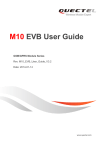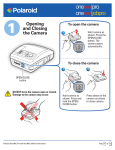Download Kodak KD40 User's Manual
Transcript
Kodak ON/OFF MODE KD40 CAMERA Equipment subject to minor appearance and specification changes. 1 Camera Identification 1 2 3 4 5 6 ON/OFF 7 MODE 8 9 13 12 2 11 10 Camera Identification 14 P C 15 () 16 17 20 19 18 3 P () FILM TIP C 26 21 4 22 23 24 27 28 25 32 31 30 29 For warranty purposes, please keep your sales receipt as proof of the date of purchase. ENGLISH Congratulations! And thank you for buying a KODAK Camera. Your new compact, 35 mm camera with motorized film advance and auto-film rewind, makes taking pictures easy. The camera uses any DX/DXN, 35 mm color or black-and-white print film with a speed of ISO 100, 200, 400, or 1000. 5 Contents Camera Identification ......................................................... 7 Specifications .................................................................... 8 Attaching the Camera Strap ............................................... 9 Loading the Battery ............................................................ 9 Loading The Film ............................................................. 11 Taking Pictures ................................................................. 14 Taking Flash Pictures ....................................................... 21 Unloading the Film ........................................................... 26 Caring for Your Camera .................................................. 27 Troubleshooting .............................................................. 28 6 Camera Identification 1 2 3 4 5 6 7 8 9 10 11 12 13 Shutter Button On/Off Button LCD Panel Mode-Selection Button Rewind Button Self-Timer Button Viewfinder Flash Film-Door Latch Lens Cover/Lens Red-EyeReduction Lamp Self-Timer Lamp Light Sensor 14 Panoramic Switch 15 Viewfinder Eyepiece 16 Film Window 17 Battery Door 18 Strap Post 19 Tripod Socket 20 Film Door 21 Film-Load Mark 22 Film Take-Up Spool 23 DX-Code Sensors 24 Film Chamber 25 Film Spindle LCD Panel 26 Self-Timer Indicator 27 Picture Counter 28 Infinity-Focus Indicator 29 Fill-Flash/FlashCharging Indicator 30 Flash-Off Indicator 31 Battery Symbol 32 Red-EyeReduction Indicator 7 Specifications Type: LCD Panel: Compact, 35 mm camera Display indicators for red-eye reduction, fill-flash/flash-charging, flash-off, infinity-focus, self-timer, and the frame number and battery symbol Lens: 28 mm, 3-element hybrid Viewfinder: Reverse-Galilean with panoramic masking in panoramic mode Film Speed: 2-step DX for ISO 100/200 and ISO 400/1000 Focus Range: Daylight: 1.2 m to infinity Flash Unit: Electronic with ISO 100/21˚, guide number of 8 m; flash automatically turns on at low-light levels Aperture: Flash: f/4.5; Daylight: f/7.0 Shutter: 1/125 sec Power Source: One 3-volt lithium KODAK K123LA (or equivalent) Battery Dimensions: 123.5 x 68.8 x 32.7 mm Weight: 170 g 8 Attaching the Camera Strap Thread the short loop of the strap under the Strap Post (18); pull the long loop through the short loop and pull it tight. Loading the Battery This camera uses a 3-volt lithium KODAK K123LA (or equivalent) Battery that supplies power for all camera operations. NOTE: This camera automatically turns off after approximately 3 minutes to conserve battery energy. 9 Battery Tips • Keep a spare battery with you at all times. Lithium batteries perform consistently until they suddenly die. • Read and follow all warnings and instructions supplied by the battery manufacturer. • Keep batteries away from children. • Do not try to take apart, recharge or short circuit the battery, or subject it to high temperature or fire. 10 • Store batteries in their original packaging prior to use. Low-Battery Indicator It’s time to replace the battery when— • the Battery Symbol (31) appears on the LCD Panel (3). • the battery symbol on the LCD panel “blinks.” • none of the indicators appear on the LCD panel. If in sunlight, turn your back to the sun and load the film in the shade of your body. 1. Slide the Film-Door Latch (9) down to open the Film Door (20). 2. Insert the flat end of the film cartridge over the Film Spindle (25). Push the other end of the film cartridge down into the Film Chamber (24) until it snaps into place. Do not force it into the film chamber. P C () FILM TIP Loading The Film 11 3. Pull out the film leader until the tip reaches the Film-Load Mark (21). Lay the film flat between the film-guide rails. FILM TIP P C 12 () If the end of the film extends past the film-load mark, gently push the excess back into the cartridge. 4. Close the film door. The film automatically advances to the first frame and the LCD Panel (3) displays “1.” Do not open the film door after you start taking pictures or you will ruin the film. NOTE: If the Picture Counter (27) on the LCD Panel (3) blinks “0,” the film is not loaded correctly. Open the film door and reload the film. ON/OFF MODE P C 13 1. Press the On/Off Button (2) to turn the camera ON. When you turn the camera on, the lens cover automatically opens. ON/OFF 14 2. Hold the camera steady. Be careful not to cover the flash or lens with your fingers. MODE Taking Pictures 3. Look through the Viewfinder Eyepiece (15) and frame your subject. For a sharp picture, stand at least 1.2 m from your subject. 4. Gently press the Shutter Button (1) completely down to take the picture. The film automatically advances to the next frame. ON/OFF Taking Panoramic Pictures (without changing rolls of film, you can switch between the panoramic and normal formats) The panoramic selection allows you to take wide-angle shots, such as large groups, football and baseball fields, landscapes, tall buildings, waterfalls, etc. Note to Owners of the Quartz Date and Time Model: Date and time imprinting is not available in the panoramic format. 15 1. Slide the Panoramic Switch (14) from normal to the panoramic position. The Viewfinder (7) changes to show the selected field of view. 2. Compose your picture within the Viewfinder Eyepiece (15) and press the Shutter Button (1). P C VIEWFINDER 3. Slide the panoramic switch down to return to the normal position. 16 Printing Panoramic Format Pictures If you took panoramic pictures on the entire roll of film, ask the processing-lab clerk to print the film only in the panoramic format. If there are panoramic and normal format pictures on the film, ask the clerk to print the film in both the normal and panoramic formats. (Normal format prints are 88.9 x 127 mm or 102 x 152 mm, whereas panoramic format prints are 88.9 x 254 mm.) You may want to consult the processing lab for development time and cost, and don’t forget to check the optional panoramic box on the photofinishing envelope. Using the Self-Timer When you want to include yourself in the picture, use the self-timer feature. 1. Use the Tripod Socket (19) to attach the camera to a tripod, or place the camera on another firm support. 2. Press the On/Off Button (2) to turn the camera ON. 17 3. Press the Self-Timer Button (6). The Self-Timer Indicator (26) appears on the LCD Panel (3) and the SelfTimer Lamp (12) glows red. approximately 10 seconds before the picture is taken. After you take the picture, the self-timer automatically turns off. ON/OFF MODE ON/OFF MODE () 4. Compose your picture and press the Shutter Button (1). The self-timer lamp “blinks” 18 NOTE: If you want to stop the selftimer operation before the picture is taken, repress the self-timer button or turn the camera off. Using the Infinity-Focus Mode To capture sharp, distant scenery, use the infinity-focus mode. ON/OFF MODE () 1. Press the On/Off Button (2) to turn the camera ON. 2. Press the Mode-Selection Button (4) to select infinity focus. Make sure the InfinityFocus Indicator (28) appears on the LCD Panel (3). 3. Press the Shutter Button (1) to take the picture. NOTE: The camera automatically returns to the auto-flash/start position after you take the picture. 19 Tips for Better Pictures • Keep your pictures simple. Move close enough to your subject so it fills the viewfinder but not closer than 1.2 m. • Take pictures at the subject’s level. Kneel down to take pictures of children and pets. • Hold your camera vertically to capture tall, narrow subjects, such as a waterfall, skyscraper, or a single person. 20 • Add interest to your picture by framing it with a tree branch, a window, or even the rails of a fence. • Keep the sun behind you. This provides the best subject illumination. Taking Flash Pictures In dim light, such as indoors or outdoors in heavy shade or on dark overcast days, you need flash. Your camera features automatic flash that fires when you need it. 1. Press the On/Off Button (2) to turn the camera ON. 2. Keep the subject within the distance range for the speed of the film in your camera (see table on next page). Be careful not to cover the flash or lens with your fingers. 3. Press the Shutter Button (1) partway down. If the FlashCharging Indicator (29) on the LCD Panel (3) “blinks,” the flash is not fully charged. Wait for the blinking to stop and the indicator to disappear before you take the picture. ON/OFF 21 4. Press the shutter button completely down to take the picture. Flash-to-Subject Distance ISO Film Flash-to-Subject Speed Distance 100 1.2 to 3.7 m 200 1.2 to 4.0 m 400 1.2 to 5.6 m 1000 1.6 to 8.9 m 22 Using the Red-Eye Reduction Some people’s eyes (and some pets’) can reflect flash with a red glow. To minimize red eye in flash or fill-flash pictures, use the redeye-reduction feature. 1. Press the On/Off Button (2) to turn the camera ON. 2. Press the Mode-Selection Button (4) once to move to the red-eye-reduction position. Make sure the Red-EyeReduction Indicator (32) appears on the LCD Panel (3). MODE ON/OFF () 3. Press the Shutter Button (1) partway down to turn on the Red-Eye-Reduction Lamp (11). Have the subject look directly at the bright, red light for 1 to 2 seconds. 4. Press the shutter button completely down to take the picture. 5. To cancel the red-eyereduction feature, turn the camera off or press the modeselection button to return to the auto-flash/start position. NOTE: When you take flash pictures using this feature, the subject’s eye pupil closes partially to reduce the red-eye effect. 23 Using the Fill Flash and Flash Off Fill Flash — Bright light indoors or outdoors from backlit subjects can create dark shadows (especially on faces) in high-contrast scenes. Use fill flash to lighten these shadows. Flash Off — When you do not want to use the flash, especially indoors where flash is prohibited, such as in theaters and museums, or in dim lighting 24 situations, use flash off. Use a tripod (tripod socket [19]) or place the camera on another firm support, and use ISO 1000speed film. 1. Press the On/Off Button (2) to turn the camera ON. 2. Press the Mode-Selection Button (4) to select fill flash (29) or flash off (30). Make sure the correct indicator for the selected mode appears on the LCD Panel (3). 3. Press the Shutter Button (1) to take the picture. NOTE: The camera automatically returns to the auto-flash/start position after you take the picture. Flash Tips • Turn on room lights and have the subject face the lights to minimize red eyes in pictures. • Stand at an angle to shiny surfaces like windows or mirrors to avoid flash reflection and bright spots in your pictures. • Keep your fingers and other objects away from the picturetaking lens and flash to avoid dark or light pictures. 25 Unloading the Film Using the Rewind Button Within a few seconds after the last picture is taken, the film automatically starts to rewind. The Picture Counter (27) on the LCD Panel (3) blinks “0” when the film is finished rewinding. Wait for the camera motor to stop before you open the film door and remove the film. Reload the camera with fresh Kodak film. If you don’t want to take pictures on the entire roll of film, you can automatically rewind the film by pressing the Rewind Button (5). 26 ON/OFF MODE () Caring for Your Camera 1. Protect the camera from dust, moisture, sudden impact, and excessive heat. CAUTION: Do not use solvents or harsh or abrasive cleaners on the camera body. 2. If the lens-cover glass appears dirty, breathe on it to form a mist and wipe the surface gently with a soft, lintless cloth or lens-cleaning tissue. Do not apply pressure or you will scratch the lens-cover glass. Never wipe a dry lens. CAUTION: Do not use solvents or solutions not designed for cleaning camera lenses. Do not use chemically treated tissues intended for cleaning eyeglasses. 3. Remove the battery when you store the camera for a long time. CAUTION: To prevent possible damage and electrical shock, do not try to take apart or repair the camera or flash unit by yourself. 27 Troubleshooting What happened Probable cause Solution Camera will not operate Power off Press on/off button Flash not ready Wait for the flash-charging indicator on LCD panel to stop blinking Film not loaded See Loading the Film There are no more pictures remaining Remove the film Battery weak, dead, missing, or improperly inserted Replace or reload the battery; see Loading the Battery 28 What happened Probable cause Solution Film does not advance Battery weak, dead, missing, or improperly inserted Replace or reload the battery; see Loading the Battery Film completely used (LCD panel has steady “0”) See Loading the Film Film not loaded properly See Loading the Film 29 What happened Probable cause Solution Film does not rewind Film did not load properly See Loading the Film Battery weak, dead, missing, or improperly inserted Replace or reload the battery; see Loading the Battery Battery weak, dead, missing, or improperly inserted Replace or reload the battery; see Loading the Battery LCD panel is blank 30 EASTMAN KODAK COMPANY Rochester, NY 14650 © Eastman Kodak Company, 1997 Pt. No. 7C9679 Kodak is a trademark. 12-97 Printed in U.S.A. 31












































